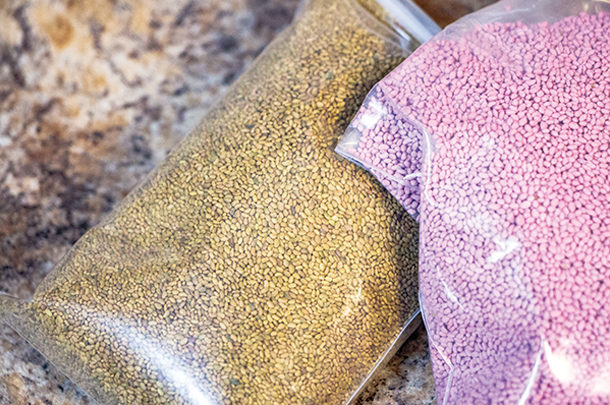The skeptics argue there is less seed in a bag of coated seed; therefore you get less for your money. They may also claim coated seed requires an increase in seeding rates to get the same stand. But research provides plenty of evidence coated seed offers substantial benefits for an alfalfa crop. Here are five reasons why.
1. Coated seed results in better stands. Critics of coated seed recommend increasing seeding rates because fewer seeds are planted per square foot. They debate the pure live seed (PLS) concept, attempting to illustrate coated seed is worth less per pound. However, farmers need to understand coated seed changes the PLS paradigm. Coated seed has a higher seed-to-seedling success rate than uncoated seed. Therefore, fewer seeds produce a similar stand.
Research by Purdue University showed coated seed produced as many seedlings per square foot as uncoated seed (29.5 and 30, respectively) when 21.8 pounds of alfalfa seed was planted per acre (uncoated = 78 PLS per square foot and coated = 56 PLS per square foot). They also planted at 14.5 pounds per acre (uncoated = 52 PLS per square foot and coated = 38 PLS per square foot) and ended up with similar stand counts for each: 31 and 29 seedlings per square foot, respectively.
2. Coated seed offers better seed-to-soil contact. Larger farms and bigger farm equipment mean a reduced amount of time spent preparing seedbeds, resulting in seed placement that is less than ideal with poor seed-to-soil contact. Coated seed offers better moisture absorption and transfer to the seed for germination. The coating material (often lime) attracts water better than the seed itself. This was verified by lab research where coated seed had about a 12 percent better germination rate than uncoated seed from the same seed lot.

3. Coated seed provides greater protection against early season pests. To verify, two sets of three seed treatments (uncoated, 9 percent coated and 34 percent coated) were sampled and chemically analyzed for the fungicide active ingredient mefenoxam. In both cases, the rate of fungicide per seed was highest on the 34 percent coated seed and lowest on the uncoated seed. This makes sense, given that dose recommendations for alfalfa are based on weight, not seeds per pound (Figure 1).

4. Alfalfa seedlings from coated seed have more vigor when disease is present. Testing under multi-race Aphanomyces root rot pressure indicated 86 percent more lateral roots and 16 percent longer roots when seeds were treated with the fungicide active ingredient and coated compared with treated seed alone (Figure 2).

The commercial 34 percent-plus coating provided an additional 12 percent increase in Aphanomyces root rot resistance over the standard 34 percent coated when comparing overall root health of the seedlings.
5. Coating helps keep products in close contact with the seed. Experience has shown coating enhances the protective effect of the single fungicide active ingredient and suggests that inoculants, additional fungicides, plant growth regulators and micronutrients are also more effective on coated seeds. As other products are added to the seed treatment, it makes sense to use coating to keep the beneficial products close to the seed.
In the end, arguments against coated seed certainly beg further question and investigation, but there is ample evidence to indicate there are tangible benefits when planting coated seed. Critics focus on the point that there is less seed in a bag of coated seed. This claim suggests there will be fewer established alfalfa plants to support a high-producing stand or that the producer is paying more for fewer seeds.
The research mentioned above proves otherwise. Coated seed increases seed efficiency by turning more seeds into healthy plants. On another point, farmers generally plant more seed than what is needed for a productive stand. Most plant above 15 pounds per acre and some as high as 25 pounds. Do the math: A 15-pound-per-acre seeding rate at 200,000 seeds per pound (34 percent coating) is about 45 seeds per square foot. The goal is to have 15 to 20 established plants by fall of seeding year. Even at 15 pounds per acre, there are more than double the seeds needed to establish a productive stand.
The debate about coated alfalfa seed may continue. Those who objectively consider and evaluate the positive aspects of coated seed will see the benefits of the technology. Today, a higher percentage of coated alfalfa seed is planted than in the past based on seed sales records, which indicates the value is becoming more evident to farmers.
If history is a predictor, coated alfalfa seed will continue to gain acceptance by farmers and in the industry. In the end, choosing elite seed genetics is by far more valuable than the concern over coated or uncoated seed. ![]()
PHOTO 1: Coated and uncoated alfalfa seed is prepped for testing at Summit Seed Coatings in Caldwell, Idaho. Photo by Lynn Jaynes.
PHOTO 2: The top row of seed pictured here is uncoated, the middle row is 9 percent coated, and the bottom row is 34 percent coated. Photo courtesy of WinField United.
Any mention of coated seed refers to 34 percent coating unless otherwise stated.
References omitted but are available upon request. Click here to email an editor.
Cliff Watrin is the PNP product development manager at WinField United Seed Treatment.










